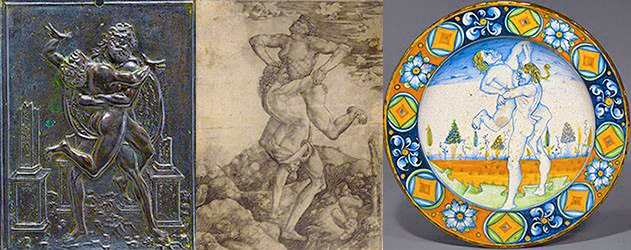The first exhibition of its kind in the United States, “Sharing Images: Renaissance Prints into Maiolica and Bronze,” is on view at The National Gallery of Art and its Sculpture Garden in Washington, D.C. through August 5. This exhibit brings together some 90 objects to highlight the impact of Renaissance prints on majolica and bronze plaquettes. It is accompanied by a publication that provides a comprehensive introduction to different aspects of the phenomenon, from the role of 15th century prints to the importance of illustrated books and the artistic exchanges between Italy and northern Europe.
Arranged chronologically, the exhibition traces the metamorphosis that designs by Andrea Mantegna, Antonio del Pollaiuolo, Raphael, Michelangelo and Parmigianino, among others, underwent across these different media.
15th century Europe was a place of technological revolution, particularly in the parallel development of printed books and images. These developments transformed the ways in which verbal and visual information could be accessed, with radical implications on cultural, scientific and artistic production. As easily produced multiples, prints traveled widely. They were frequently copied by artists and craftsmen and were a driving force in the revolution of the arts of the Renaissance.
Small bronze reliefs known as plaquettes, functioned primarily as refined ornaments or collectibles, a format influenced by ancient carved gems, coins and statues, first appeared in Rome around 1440. As small, portable objects meant to be handled and privately enjoyed, plaquettes were similar to prints and often produced in or near important printmaking centers such as Mantua, Bologna and Venice.
Inspired by the availability of new pigments, glazes and printed models, ceramic artists developed a style of decoration called istoriato that featured recognizable subjects and narrative episodes from classical and contemporary literature, as well as Biblical and ancient history. For the first time, pottery painters conceived of the surfaces of plates and vessels as a medium to depict stories in full color and vivid detail. Like prints, istoriato mirrored and visualized the interests and passions of the cultured elite while remaining accessible to a wider market. Painters in the principal cities of istoriato production – Faenza, Urbino, Pesaro and Gubbio, could respond to the most recent developments in contemporary art thanks to the availability of printed images created in major artistic centers.
The National Gallery of Art and its Sculpture Garden are free to the public and located on the National Mall between 3rd and 9th Streets at Constitution Avenue NW. It is open Monday through Saturday from 10:00 am to 5:00 pm and Sunday from 11:00 am to 6:00 pm. For information call 202-737-4215 or visit the Gallery’s Web site at www.nga.gov.





